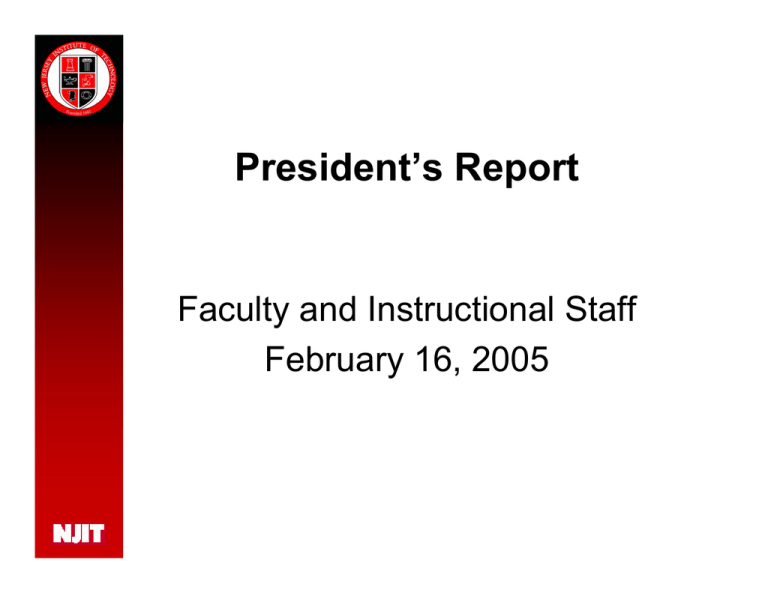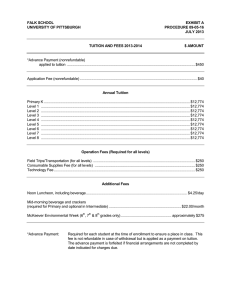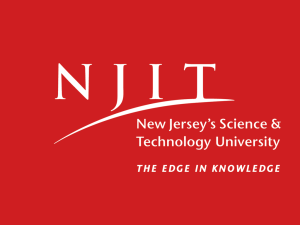President’s Report Faculty and Instructional Staff February 16, 2005
advertisement

President’s Report Faculty and Instructional Staff February 16, 2005 Updates • Landscape Master Plan • • • • Final draft complete All-campus meeting to solicit input Board of Trustees Planning Committee Board of Trustees • RFQ is out • • Marketing plan completed by Cognitive Marketing RFQ out for marketing consultant • Campus Master Plan • Marketing • FY06 Budget • Strategic Plan Objectives Updates • FY06 Budget • $4B shortfall, some structural (due to one time • fixes) some due to revenue shortfalls Some approaches considered ($2 to $3B) •Rolling back income tax cut •Eliminating property tax rebates •Conversion of BCBS from non-profit to publicly traded corporation •………… NJIT Tuition & Fees Compared to State Appropriation $12,000 $11,000 $10,000 $9,000 $8,000 $7,000 $6,000 $5,000 $4,000 State $ Per Full-Time Equivalent Students FY 04 FY 02 FY 00 FY 98 FY 96 FY 94 Actual Tuition & Fee Income Per Full-Time Equivalent Student NJ Public Colleges and Universities Total Tuition & Fees Compared to S tate Appropriation $12,000 $11,000 $10,000 $9,000 $8,000 $7,000 $6,000 $5,000 $4,000 $3,000 $2,000 State $ Per Full- Time Equivalent Students 20 04 FY 20 03 FY 20 02 FY 20 01 FY 20 00 19 99 FY FY 19 98 FY 19 97 FY 19 96 FY 19 95 FY FY 19 94 Actual Tuition & Fee Income Per Full- Time Equivalent Student Effect of Inflation on Tutition+Fee+Appropriation Revenue per FTE CPI for NE Urban Area $20,000 $19,000 $18,000 Tuition, Fee & Base Approp. Per Full-Time Equivalent Student $17,000 $16,000 Net Present Value $15,000 $14,000 $13,000 FY 94 FY 95 FY 96 FY 97 FY 98 FY 99 FY 00 FY 01 FY 02 FY 03 FY 04 FY 05 $12,000 Total Effect of Inflation on Tuition + Fee + Appropriation Revenue per FTE at New Jersey Public Colleges and Universities; CPI for NE Urban Area $20,000 $18,000 Tuition, Fee & Base Approp. Per Full- Time Equivalent Student $16,000 $14,000 Net Present Value Base Approp. Per Full- Time Equivalent Student $12,000 $10,000 20 04 20 03 FY 20 02 FY 20 01 FY 20 00 FY 19 99 FY 19 98 FY 19 97 FY 19 96 FY 19 95 FY FY FY 19 94 $8,000 NJIT % of Educational Costs 65% 60% 55% 50% State Percentage 45% Student percentage 40% 35% FY 04 FY 02 FY 00 FY 98 FY 96 FY 94 30% Total % of Educational Costs 65% 60% 55% 50% State Percentage 45% Student Percentage 40% 35% 20 04 FY 20 03 FY 20 02 FY 20 01 FY 20 00 FY 19 99 FY 19 98 FY 19 97 FY 19 96 FY 19 95 FY FY 19 94 30% NJIT Budget Priorities Fiscal Year 2006 • Operating Support: $9.1 million additional support including salary support, cost of inflation, and support to minimize tuition increases. Consistent with the Presidents’ Council Budget Policy Statement request of $79.2 million additional support for the three public research universities (NJIT: $9.1 million; Rutgers: $53.0 million; UMDNJ: $17.1 million) • New Jersey Homeland Security Technology Systems Center: $1.0 million new support to develop professional staff of the Center housed at NJIT (designated by Executive Order 111). Currently, there is little to insure that technology purchased by local, county, state and federal levels will lend itself to integrated usage to create a comprehensive web of protection. Basic standards of performance and interoperability are lacking in a rapidly expanding market. The Center will: ¾ Coordinate and collaborate with New Jersey’s domestic security stakeholders in business, government, and academia to serve as the State’s homeland security consultant for technology evaluation, development of prototypes of integrated homeland security systems for testing, demonstration, and training, and urgently needed performance standards to inform the purchase of homeland security products by state, county, and municipal agencies. ¾ Leverage New Jersey’s core research strengths in information technology, telecommunications, applied life sciences, sensors and devices, and materials through the development of partnerships that engage State agencies, universities, military installations, and the private sector to address the challenge of defending our region from terrorist attacks. ¾ Serve as an economic development catalyst for New Jersey and Newark. The State is a perfect test bed for virtually every aspect of homeland security, and it is anticipated that companies will desire to be close to where large-scale system tests will be conducted and performance standards set that will affect technologybuying patterns. • Capital Support: $3.9 million new support for critical facilities renewal and replacement representing less than 1% of the replacement value of current plant assets (less than the 1½ to 3% recommended by the Association of Higher Education Facilities Officers). Consistent with the Presidents’ Council Budget Policy Statement request of $36.0 million of for the twelve senior public institutions. • Student Aid: full programmatic funding of the following applicable to current tuition levels: The Tuition Aid Grant (TAG), the Educational Opportunity Fund (EOF), Outstanding Scholar Recruitment Program (OSRP), and the Student Tuition Assistance Reward Scholarship (STARS) consistent with the Presidents’ Council Budget Policy Statement request at $14.3 million in new support. Updates • Strategic Plan Objectives -- Become nationally recognized for attracting high achieving students from diverse national and international populations. •Increase enrollment by fall of 2008: -- in the Dorman Honors College to 1 of 5 freshmen -- of newly admitted undergraduate students, excluding undeclared, to o 25% women, and o 15% African-American, and o 15% Hispanic. •Increase the graduation rate of first-time, full-time freshmen (FTFTF) to 55% by fall 2010. •For an incoming freshman class of at least 750 students, Increase the mean SAT score by 20 points by 2005. Updates • Strategic Plan Objectives -- Become nationally recognized for attracting high achieving students from diverse national and international populations. •Increase enrollment by fall of 2008: -- in the Dorman Honors College to 1 of 5 freshmen -- of newly admitted undergraduate students, excluding undeclared, to o 25% women, and o 15% African-American, and o 15% Hispanic. •Enhance the diversity of the faculty to mirror the percentage of AfricanAmerican, Hispanic, and women terminal degree recipients working in academia by 2010. •Increase the graduation rate of first-time, full-time freshmen (FTFTF) to 55% by fall 2010. •For an incoming freshman class of at least 750 students, Increase the mean SAT score by 20 points by 2005.




